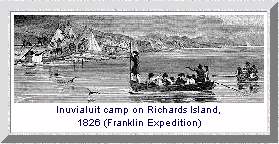


... To 1902 - Trade with Europeans
European trade goods were already widely available through indirect trade. Russian iron goods were in circulation by the late eighteenth century, brought east from Bering Strait by Alaskan Inupiat intermediaries. By the late 1820s this was supplemented by Hudson's Bay Company wares, traded downriver from Fort Good Hope (established in 1826) by Hare Indian traders.

In 1840, the Hudson's Bay Company established Peel's River Post (later called Fort MacPherson) on the lower Peel River just upstream from Point Separation. For its first ten years of existence it attracted only Gwich'in, the Inuvialuit remaining aloof from direct trade. But during the early 1850s they began to visit the fort in ever-increasing numbers. One early and beneficial effect of this trade was a suspension of hostilities with the Gwich'in, although the two long remained suspicious and distrustful of one another.
Most of this new-found trade consisted of white and red fox pelts, given in exchange for items such as metal fish hooks, glass beads, metal pots (often cut up as a useful source of metal), iron knives, hatchets, and above all tobacco. Initially the Hudson's Bay Company, like their Dene allies, were much afraid of the Inuvialuit, who were much more warlike than other Canadian Inuit. As a result the sale of firearms was expressly forbidden, although a few guns did reach Inuvialuit hands in the 1850s, mainly from Hare Indians who had much better relations with eastern Inuvialuit than did the Gwich'in with the Mackenzie River people. By the 1870s, this moratorium was over and guns appeared in regular use. Alcohol, however, did not follow suit. It was not apparently stocked in quantity by any of the far northern posts, and early Inuvialuit reports of it were not favourable. 

[Opening Page | The Land | The People | From Ancient Times | ...to 1902 | Survival |About the Researcher]